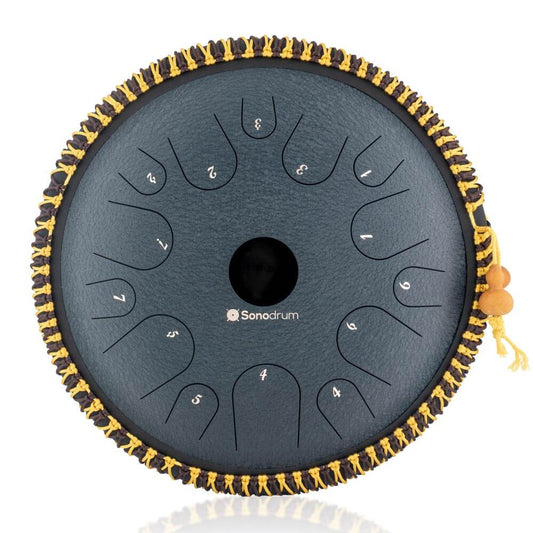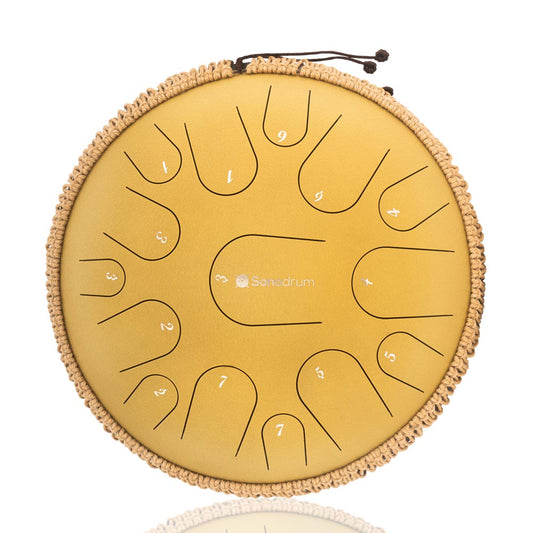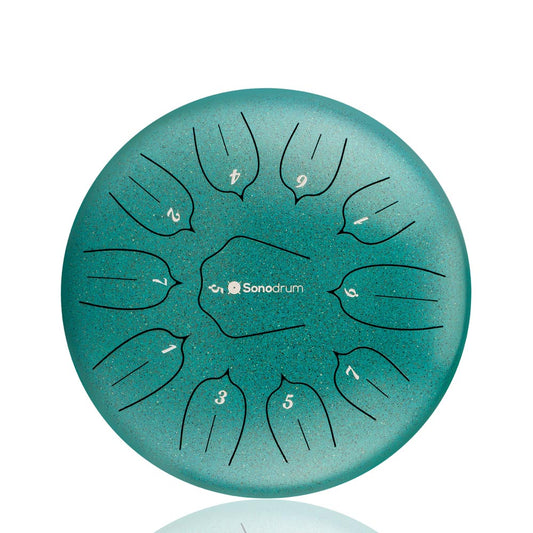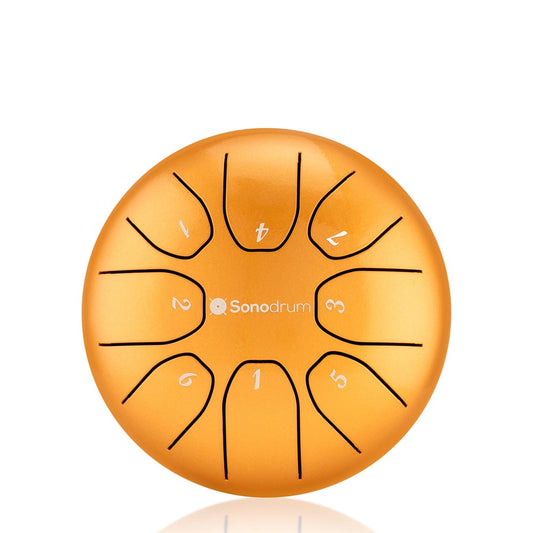Welcome to the world of steel tongue drum playing. Here, you can learn to create soothing sounds. It's a journey for beginners, perfect for those who love relaxation and creativity.
The steel tongue drum has a unique sound. It's great for unwinding and showing your creativity. This guide will teach you the basics and get you started on your musical journey.
Introduction to Steel Tongue Drum Playing
Learning steel tongue drum techniques is exciting. The steel tongue drum brings people together, creating a sense of community. It's perfect for solo playing or with others, helping you explore your musical side.
Key Takeaways
- Learn the basics of steel tongue drum techniques to get started with your musical journey
- Discover the benefits of playing the steel tongue drum for beginners, including relaxation and stress relief
- Explore the different types of steel tongue drums available for beginners
- Understand the importance of proper technique when playing the steel tongue drum
- Find inspiration in the steel tongue drum community and online resources
- Start with simple steel tongue drum techniques and gradually move on to more complex ones
Understanding the Steel Tongue Drum: Origins and Sound
The steel tongue drum has a unique sound that is both captivating and soothing. To appreciate this instrument, it's essential to understand its origins and how it produces sound. Playing the steel tongue drum requires a basic understanding of its history and construction.
The history of the steel tongue drum is fascinating, with its roots in traditional instruments from around the world. The sound produced by the steel tongue drum is a result of its construction and the materials used.
History of the Steel Tongue Drum
The steel tongue drum has evolved over time, with various cultures contributing to its development. From its early beginnings to the present day, the steel tongue drum has been shaped by the creativity and innovation of musicians and craftsmen.
How the Instrument Produces Sound
The steel tongue drum produces sound when the tongues or keys are struck, causing the metal to vibrate and produce a rich, resonant sound. This sound is often used in steel tongue drum music to create a sense of calm and relaxation.
Different Types of Steel Tongue Drums
There are several types of steel tongue drums available, each with its own unique characteristics and sound. Some of the most common types include:
- Standard steel tongue drums
- Handpan drums
- Tongue drums with additional sound holes
By understanding the different types of steel tongue drums and their characteristics, you can make an informed decision when choosing your first drum and start playing the steel tongue drum with confidence.
Choosing Your First Steel Tongue Drum
Choosing a steel tongue drum can be tough, especially for beginners. There are many options, making it hard to decide. Look at the size, material, and price to find the right one for you.
The size of the drum is important. They come in different sizes, from small to large. Beginners should pick a size that feels right. Steel tongue drum lessons can help you choose the best size. Also, think about the material, as it affects the sound and how long it lasts.
Here are some things to think about when picking your first steel tongue drum:
- Size: Think about how big the drum is and if it fits where you play.
- Material: Consider the material and how it changes the sound and durability.
- Price: Decide how much you want to spend and find a drum that fits your budget.
By thinking about these points and taking steel tongue drum lessons, you can find the perfect drum. Choose one that feels good to play and fits your budget.
| Drum Size | Material | Price |
|---|---|---|
| Small | Steel | $200 |
| Medium | Steel | $300 |
| Large | Steel | $400 |
Essential Equipment for Steel Tongue Drum Players
Starting your steel tongue drum practice? You'll need the right gear to make it better. Quality accessories can protect your drum, improve sound, and open up new musical paths.
Choosing the right mallets and strikers is key. They let you create different tones and sounds. This way, you can express yourself better through music.
Mallets and Strikers
- Soft mallets for gentle, soothing sounds
- Hard mallets for louder, more resonant tones
- Specialty strikers for unique effects and textures
Carrying Cases and Accessories
A sturdy carrying case keeps your drum safe and easy to carry. Also, tools like tuning devices and cleaning cloths keep it in top shape. This ensures it sounds its best.
https://youtube.com/watch?v=Hg9FswG1hQA
Optional Sound Enhancement Tools
Want to explore more sounds? Amplifiers and effects pedals can add to your practice. They let you create a variety of sounds and textures, opening up new musical avenues.
| Equipment | Purpose |
|---|---|
| Mallets and Strikers | Produce a wide range of tones and dynamics |
| Carrying Cases and Accessories | Protect and maintain the steel tongue drum |
| Optional Sound Enhancement Tools | Expand sound possibilities and create new textures |
How to Play a Steel Tongue Drum: Basic Techniques
To start playing the steel tongue drum, you need to learn the basics. It takes patience and practice, but with effort, you'll get better fast. First, get to know the instrument and how to hold your hands right. This is key for clear sounds.
For basic techniques, remember a few important things. Holding your hands correctly is crucial for playing well. Try different ways to see what works for you. Also, learning how to make different sounds will help a lot.
Some key techniques to focus on when learning how to play a steel tongue drum include:
- Developing finger independence and dexterity
- Practicing different striking methods, such as using mallets or fingers
- Experimenting with various sound production techniques, such as changing the pitch or tone
Mastering these basic techniques will help you make beautiful music. Don't forget to practice often and have fun. The steel tongue drum offers many sounds and techniques to explore.
| Technique | Description |
|---|---|
| Hand Positioning | Proper hand positioning is crucial for producing clear and resonant sounds |
| Striking Methods | Experiment with different striking methods, such as using mallets or fingers |
| Sound Production | Understand the basics of sound production, including pitch and tone |
Understanding Notes and Scales on Your Drum
To make beautiful music with your steel tongue drum, you need to know steel tongue drum notes and steel tongue drum scales. As you get better, learning these will unlock new musical doors. You can play your favorite tunes, write your own songs, and explore many music styles.
Here are some key points to consider when learning steel tongue drum notes and steel tongue drum scales:
- Start by getting to know the different notes on your drum, like the tonic, dominant, and subdominant.
- Practice playing scales, like the pentatonic or diatonic, to get better and understand steel tongue drum scales better.
- Try out different rhythms and time signatures to make your music more interesting.
Mastering steel tongue drum notes and steel tongue drum scales lets you create deep, rich sounds. This shows off your talent and creativity. Don't forget to practice often and enjoy exploring steel tongue drum music.
With hard work and practice, you'll unlock your steel tongue drum's full potential. You'll make music that touches people's hearts.
| Note | Scale | Description |
|---|---|---|
| Tonic | Pentatonic | A five-note scale commonly used in steel tongue drum music |
| Dominant | Diatonic | A seven-note scale used in various musical genres |
Creating Your First Melodies
Now that you know the basics, it's time to make your own steel tongue drum melodies. Start with simple patterns, learn about rhythm, and build melodic progressions. These steps will help you create unique tunes and express yourself through creating music on the steel tongue drum.
Simple Pattern Development
Creating melodies starts with simple patterns. Try different note combinations and rhythms to find a sound you like. Begin with one note and add more to form a pattern. Keep it simple to make it easier to expand on.
Rhythm Basics
Rhythm is key in music. Start with basic rhythms like 4/4 time and then try more complex ones. Remember, it's okay to make mistakes. They're part of learning.
Melodic Progressions
Melodic progressions are about connecting notes to make a melody. Experiment with different combinations and rhythms. Keep it simple to build on your ideas. With practice, you'll create your own steel tongue drum melodies that show your style.
| Pattern Development | Rhythm Basics | Melodic Progressions |
|---|---|---|
| Experiment with note combinations | Practice basic rhythms | Create a series of notes that flow together |
| Keep patterns simple and repetitive | Experiment with complex rhythms | Keep melodic progressions simple and repetitive |
Advanced Playing Techniques and Methods
As you get better at playing the steel tongue drum, it's key to learn advanced steel tongue drum techniques. This will help you improve your skills. You'll learn complex patterns, how to control dynamics, and more.
Some important things to work on include:
- Developing finger independence and dexterity
- Experimenting with different mallets and strikers
- Practicing advanced rhythms and time signatures
Adding steel tongue drum advanced lessons to your practice will make your music richer. It will add depth, emotion, and sophistication. This will make your playing more engaging and fun for listeners.
Learning advanced techniques takes time and effort. Be patient and keep practicing. With dedication, you'll see big improvements in your playing.
Incorporating Meditation and Mindfulness
The steel tongue drum is great for music and meditation. Using it for steel tongue drum meditation can improve your mental and emotional health. It combines the drum's soothing sounds with mindfulness to bring deep relaxation and peace.
To begin your mindfulness with the steel tongue drum journey, focus on your breath. Play the drum and listen to its rhythm and your breath. This helps you feel calm and clear. Try different playing methods, like mallets or hands, to make unique sounds.
For better meditation, make meditative sequences with your steel tongue drum. Play repetitive patterns or melodies to focus your mind. Use the drum to create a space that lets you fully be in the moment.
Benefits of Steel Tongue Drum Meditation
- Reduces stress and anxiety
- Improves focus and concentration
- Enhances creativity and self-expression
- Fosters a sense of calm and inner peace
Adding steel tongue drum meditation and mindfulness with the steel tongue drum to your daily life has many benefits. It's not just for musicians. The steel tongue drum can help anyone find mindfulness and peace.
Maintaining and Caring for Your Steel Tongue Drum
To keep your steel tongue drum sounding great, follow proper steel tongue drum care steps. This means cleaning, storing, and tuning it regularly. This way, you'll enjoy your instrument for many years and keep it in good shape.
For maintaining the steel tongue drum, remember a few important tips. Here's how to start:
- Regularly clean your drum with a soft cloth to remove dirt and debris
- Store your drum in a dry, cool place to prevent damage
- Tune your drum regularly to ensure it's sounding its best
By following these easy tips, you'll keep your steel tongue drum in excellent condition. It will continue to sound amazing. Remember, proper steel tongue drum care is key to making your instrument last longer and enhancing your playing experience.
It's also wise to create a regular maintenance routine. This can include checking the drum's tuning, cleaning the playing surface, and looking for any damage. By staying on top of maintaining the steel tongue drum, you'll play with confidence and precision.
Common Mistakes to Avoid
Playing the steel tongue drum can be fun, but knowing common mistakes is key. Steel tongue drum mistakes can be annoying, but avoiding them saves time. One big mistake is wrong hand placement, which affects sound quality and comfort.
To play well, you need to know the basics. Here are some tips to help you start:
- Start with the correct hand positioning and posture to ensure comfortable playing.
- Practice basic striking methods to produce clear and resonant sounds.
- Listen to recordings of experienced players to develop your ear and improve your technique.
By avoiding these steel tongue drum mistakes, you can get better and enjoy playing. Stay relaxed, have fun, and keep practicing to beat common errors in steel tongue drum playing.
With patience and hard work, you can master the steel tongue drum and make beautiful music. Don't get down by mistakes – they're chances to learn and grow.
| Mistake | Correction |
|---|---|
| Incorrect hand positioning | Adjust hand position to ensure comfortable playing |
| Poor striking technique | Practice basic striking methods to produce clear sounds |
| Insufficient practice | Set aside time each day to practice and improve technique |
Building a Practice Routine
To get better at playing the steel tongue drum, you need a regular steel tongue drum practice routine. Make it fit your life and goals. This way, you'll keep improving and stay excited about playing.
Start by picking a time each day to practice. Even 15-20 minutes is good. Use this time for simple exercises and techniques to improve with the steel tongue drum.
Daily Exercise Suggestions
- Warm-up exercises: Begin with easy striking patterns to loosen up your hands and get used to the drum.
- Scale practice: Work on playing different scales and arpeggios to better your technique and musicality.
- Improvisation: Spend time improvising and trying out new sounds and rhythms.
Progress Tracking Methods
To see how you're doing, keep a practice journal or record yourself. This will show you where you need to get better and how far you've come in your steel tongue drum practice routine.
Stick to a regular practice routine and track your progress. This way, you'll improve with the steel tongue drum and enjoy all its benefits.
| Practice Routine | Duration | Focus |
|---|---|---|
| Warm-up exercises | 5-10 minutes | Loosening up hands and getting comfortable with the drum |
| Scale practice | 10-15 minutes | Improving technique and musicality |
| Improvisation | 10-15 minutes | Experimenting with different sounds and rhythms |
Conclusion: Your Journey with the Steel Tongue Drum
As you finish this guide on playing the
Whether you're new or have some music experience, the
Keep sharing your love for the
The
FAQ
What is a steel tongue drum?
A steel tongue drum is a special musical instrument. It makes calming sounds. It has a steel body with metal plates called "tongues" that produce different notes when hit.
How does a steel tongue drum produce sound?
Sound comes from the metal tongues vibrating. When hit, they make a unique sound. You can change the sound by how you hit the drum.
What are the different types of steel tongue drums?
There are many types of steel tongue drums. You can find circular ones, handpans, and newer designs. Each has its own look and sound.
What equipment do I need to start playing the steel tongue drum?
You'll need the drum, mallets or strikers, and a case or stand. You might also want sound tools like resonators.
How do I properly hold and strike a steel tongue drum?
Hold the drum right and strike it gently. Use your fingers or mallets. This makes the best sound.
How do I learn to play notes and scales on the steel tongue drum?
First, learn the layout of your drum. Then, practice simple scales and chords. This helps you play melodies and harmonies.
What are some advanced playing techniques for the steel tongue drum?
Try playing complex rhythms and add dynamics. Experiment with different striking methods. This creates unique sounds.
How can I use the steel tongue drum for meditation and mindfulness?
The drum's calming sounds are great for meditation. Play simple patterns or improvise. This helps you relax and find inner peace.
How do I properly maintain and care for my steel tongue drum?
Clean and store your drum right. Follow the maker's care tips. This keeps your drum sounding great for years.
What are some common mistakes to avoid when learning to play the steel tongue drum?
Don't hit too hard and keep your hands right. Practice regularly. Avoiding these mistakes helps you learn faster and enjoy playing more.




